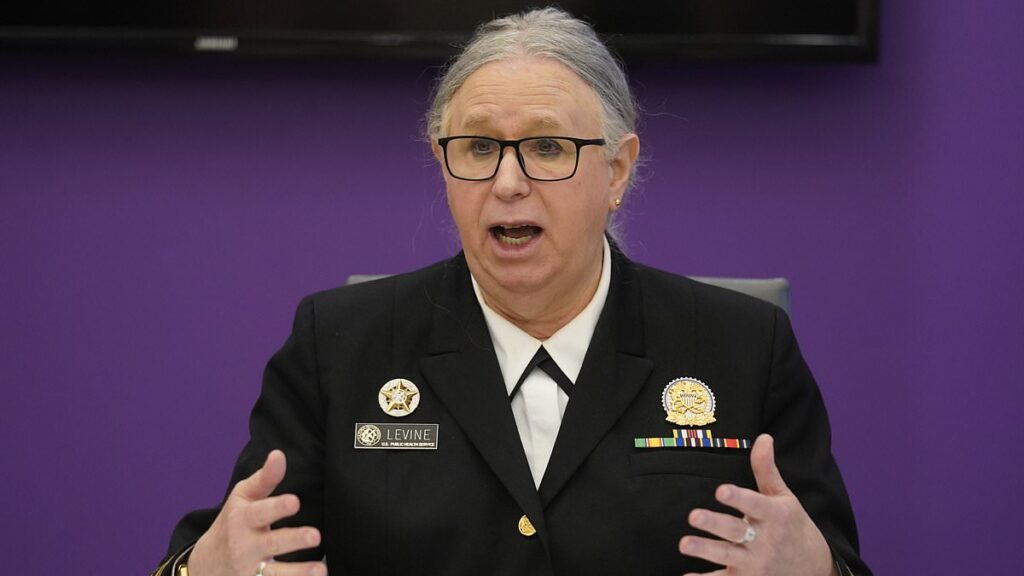Three transgender military veterans may have developed cancer from taking sex change drugs, a report has revealed.
The patients were all born male but identified as female and had recently been prescribed the hormone estrogen to make them more feminine.
They each had several risk factors that increases their chance of thyroid cancer, including smoking, obesity, and exposure to radiation.
But doctors who treated them said ‘it is conceivable’ that their hormone therapy played a role based on past research linking estrogen to tumor growth.
The doctors are now calling for transgender people to be warned about the risks of cancer from gender-affirming drugs.

A report published earlier this year detailed the cases of three transgender military veterans who were all diagnosed with thyroid cancer after receiving hormone therapy (stock image)

The number of military personnel diagnosed with gender dysphoria has risen from 1,892 in 2020 to 3,700 in 2024, according to data from Defense Health Agency
The report was published earlier this year in the journal Endocrine and Metabolic Science by experts from the University of California Davis.
They wrote that while gender-affirming hormone therapy (GAHT) with estrogen ‘is a cornerstone of treatment of transgender women…thyroid cancer has been associated with estrogens.
‘Clinicians should be aware of this and discuss it with transgender women—in the context of limited data on thyroid cancer in this population—to eliminate health disparities.’
The experts suggested that the estrogen in the gender-affirming drugs may have led to malignant cells in the thyroid growing, which could lead to cancerous tumors or benign masses becoming cancerous.
According to data from the Department of Defense, the number of transgender US Army members has doubled from 1,800 to 3,700 since 2020.
This is less than one in 100 of the total active duty Army personnel in the US.
The Williams Institute at UCLA estimates that 15,500 transgender individuals are serving in the US military as a whole.
And figures from Defense Health Agency show that in the past three years, $17.5million in taxpayer money was spent on psychotherapy for trans service people and $1.5million went towards hormone drugs.
A further $7.6million funded gender-affirming surgeries, including facial tweaks to make a recruit more masculine or feminine, and the removal or creation of breasts and genitals.
The report comes as thyroid cancer is expected to affect 44,000 patients this year and kill 2,100.
It is also one of America’s fastest growing cancers, which experts have blamed on environmental factors like exposure to ‘forever chemicals.’
All three patients in the case report were diagnosed with papillary thyroid cancer, which accounts for about eight in 10 thyroid cancer cases.
When caught early, more than nine in 10 patients survive after five years. This drops to about half when the cancer spreads to other areas.
The first patient was 49 years old when they were diagnosed with cancer in 2002, five years after starting on hormone replacement therapy.
In addition to being on estrogen therapy, the patient also had ‘significant radiation exposure’ due to helping with cleanup from Chernobyl nuclear disaster.
The patient was also obese with a BMI of 32.
They had their thyroid removed in 2003 and later went into remission. They discontinued estrogen therapy in 2008 and had a breast reduction two years later.
The patient resumed hormone replacement therapy in 2016.
The second patient was diagnosed with papillary thyroid cancer at age 55 in 2011. They had started hormone therapy three years prior and had a vaginoplasty, a surgery to create a vagina and vulva, in 2009.
They had no family history or history of risk factors like smoking or radiation exposure. However, they were obese with a BMI of 30.
The doctors noted that at the time of their diagnosis, the patient was taking an ‘unknown total dose’ of estrogen pills.
The patient had their thyroid removed two months after their diagnosis and had no recurrence. It’s unclear if they continued with gender-affirming care.

One of the most famous examples of transgender military personnel is Admiral Rachel Levine, a four-star officer sworn in as Admiral of the Public Health Services Commissioned Corps in 2021 (pictured here in 2022)

Since 2020, $17.5 million was spent on psychotherapy, $1.5 million on hormone therapy and $7.6 million on gender-affirming surgeries, according to Defense Department data provided to DailyMail.com

A recent analysis of more than 400 cases showed the most severe side effects and reactions patients undergoing hormone therapies have experienced
The third patient was 64 when they were diagnosed with thyroid cancer in 2017, just three months after starting estrogen therapy.
However, doctors had found a benign thyroid tumor five years earlier. They noted that because the nodule was benign until starting hormone therapy, it’s possible that the treatment turned it cancerous.
Though the patient was not overweight and had no family history of the disease, they smoked more than 50 packs of cigarettes a year, raising thyroid cancer risk.
The patient did not undergo surgery due to heart disease and chronic obstructive pulmonary disease (COPD) caused by smoking.
In 2021, the patient died from atherosclerotic cardiovascular disease, a heart condition caused by plaque building up inside the arteries, making it difficult for blood to flow throughout the body.
The researchers noted that gender-affirming care was the only common denominator between the three patients, as they all otherwise had different risk factors for thyroid cancer.
However, they also wrote that the evidence suggesting that estrogen could increase thyroid cancer risk is mixed and mainly performed in animals.
Dr Hiba Tariq Basheer, health sciences assistant clinical professor at UC Davis, said in a press release: ‘We are being cautious with our findings, but further research is needed to ascertain the role of estrogen gender‐affirming hormone therapy and thyroid cancer.’










